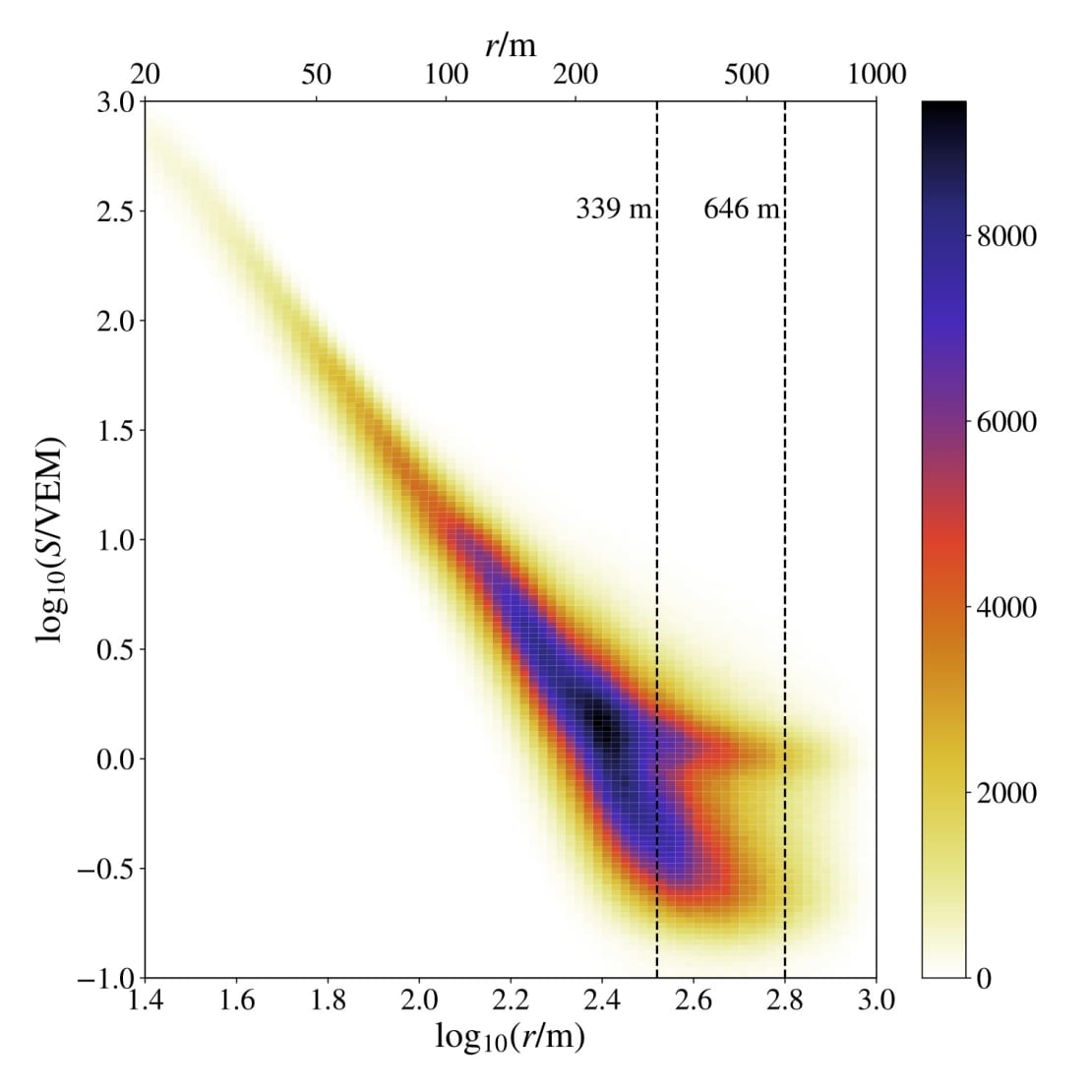It took a solar eclipse and a balloon flying up to 5,300 meters to point to outer space as the origin of the ionizing radiation in the atmosphere. The discovery of cosmic rays was made by Victor Hess in 1912 and earned him the Nobel prize in 1936.
Since then, scientists around the world use extensive air showers (EAS) of secondary particles produced by cosmic rays in the atmosphere to study the origin and composition of the primary cosmic rays.
In a new paper submitted to Physical Review D, the IceCube Collaboration presents new measurements of the muon content of cosmic-ray air showers with energies from PeV to EeV and broadens the test of hadronic interaction models by measuring the GeV muon content in air showers. These results shed new light on the puzzling discrepancies between data and theory, which may provide hints about new physics.

At energies above 100 TeV, EAS detection is performed by arrays of detectors that can cover large areas from one to even thousands of square kilometers. The detectors measure the cascade of secondary particles produced by the interaction of a cosmic ray in the atmosphere that impact large areas when they reach ground level.
This analysis uses three years of data from the IceTop detector, the surface array of the IceCube Neutrino Observatory, which serves both as a cosmic-ray detector and a veto for neutrino measurements. IceTop is made up of 81 stations sitting at the top of each of the IceCube in-ice strings of optical detectors, which are mostly used to analyze neutrino interactions. In general, stations are spaced about 125 meters apart spread over a square kilometer near the South Pole.
IceTop, as other EAS detectors, can infer the properties of the initial cosmic ray from measurements of secondary particles that reach Antarctica’s ice sheet, which rely on Monte Carlo simulations and models that describe particle interactions in the atmosphere. The problem is that, when compared to data, these simulations show significant discrepancies that physicists refer to as the “muon puzzle,” since the models do not correctly describe the production of muons in these air showers.

Aerial view of the IceTop detector near the Admunsen-Scott South Pole Station in Antarctica. Each circle shows an IceTop station as well as the location of an IceCube string. Colors indicate the years that the stations were deployed.
This is the first IceCube measurement of the muon content of cosmic-ray air showers at energies from PeV to EeV, and it provides new data to test models that researchers use to predict the composition and energy spectrum of the shower of particles produced by cosmic-ray interactions in the atmosphere.

While cosmic-ray showers include a large number of different particles—among them muons, hadrons, photons, and electrons—muons become dominant at distances of several hundred meters from the central region of the air shower. “In IceTop, these muons create a characteristic signal that we have dubbed the ‘muon thumb,’” explains Dennis Soldin, a postdoctoral researcher at the University of Delaware, who led this study. In the image at left, the “thumb” is shown for the distribution of muon signals of near-vertical showers with reconstructed energies between 10 PeV and 12.5 PeV.
This unique signature can also be reproduced with Monte Carlo simulations that were fitted to experimental data for cosmic-ray interactions taking place at distances
of 600 and 800 meters from the shower core. The comparison included several hadronic interaction models ranging from more classic models to the colloquially known “post-LHC models,” which take into account high-energy data from current CERN experiments.
“What we have shown is that IceTop data agrees well with a wide variety of ‘pre-LHC’ predictions assuming any realistic composition models. However, this is not the case for post-LHC models, like EPOS-LHC, which produce higher muon densities than those observed in IceTop,” says Soldin. Moreover, this discrepancy conflicts with observations above 1 EeV by other experiments that measured higher muon densities than the same models, thus pointing to a different behavior depending on the cosmic-ray energy.
With the addition of this IceTop measurement, astrophysicists are now able to study the energy-dependence of this discrepancy with data covering four orders of magnitude in cosmic-ray energy.
The muon puzzle, as its name suggests, does not have an easy explanation. And that is why scientists from different experiments are working together in the international “Working Group for Hadronic Interactions and Shower Physics” (WHISP). Among them, this new IceTop measurement provides unique and high-quality data at slightly lower cosmic ray energies than other experiments. The results confirm that the discrepancy between theory and data increases with energy, which could help explain its origin.
Further improvements from IceCube include a measurement of coincident GeV muons in IceTop with TeV muons in IceCube. This analysis is already in progress and will provide a new test for hadronic interaction models not accessible to any other experiment. Future improvements are expected to explore the angular dependence of the muon flux. All in all it should significantly contribute to finding the origin of the muon puzzle, which scientists speculate could happen within the next decade.
Previous to these results, the IceTop detector had already contributed outstanding results to cosmic-ray science. We measured the cosmic-ray energy spectrum in the range from PeV to EeV, which presented deviations from a simple power-law behavior in this region and which includes the transition between a galactic and an extragalactic origin of these particles. These were further improved, thanks to machine learning techniques, down to 250 TeV and up to 10 PeV. We also extended the measurements of the cosmic-ray anisotropy to PeV and confirmed a strong dependence of the small variations observed in the flux of cosmic rays at multiple angular scales.
+Info “Density of GeV muons in air showers measured with IceTop,” IceCube Collaboration: R. Abbasi et al., Physical Review D 106 (2022) 3, 032010, journals.aps.org, arxiv.org/abs/2201.12635